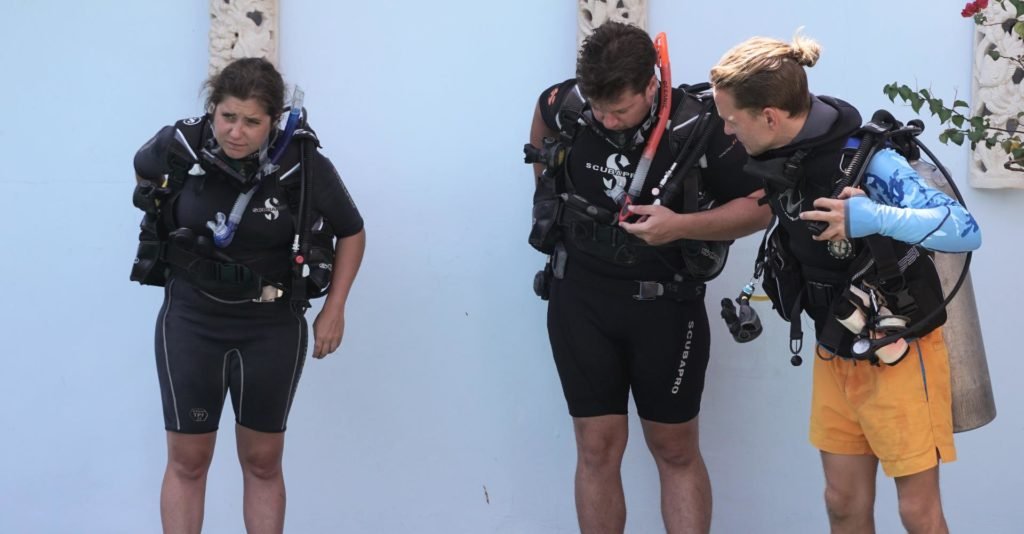As a dive guide, I keep finding new divers who have no idea they have dump valves, what they’re for or when to use them. As they’re drifting upwards, head down, feet kicking wildly, they grab for their direct system / low-pressure inflator (LPI) and hold it out (now pointing almost straight down) and are totally confused as to why they’re having an uncontrolled ascent.
Some new divers are checking their dump valves during a buddy check, but it’s done out of rote; there’s no understanding behind their actions.
This is dangerous.
Dump valves
Many BCDs have three dump valves, but many have fewer (in very old BCDs or wing-styles). Some have two dump valves, but only direct control for one (like in Aqualung’s i3-based BCDs). Learn what your BCD is capable of.
Left shoulder
This is the most prone to breakage. Pull on your Low Pressure Inflator (LPI – the big tube connecting to the BCD, not the small hose to your regulator), and your left shoulder should vent. Not every BCD has this, so check first during a buddy check – and please don’t try to rip it off.
Right shoulder
This is the most common and often best one to use. Tug the toggle to open the valve, don’t be afraid of it, this one is easy to have a bit of control over.
Right back
Or, the butt valve, as I call it. Usually right above your right buttock, there is a toggle dangling. Some BCDs (often Cressi) thread the valve toggle to the front on the right side, just below where you normally would store your alternate air source.

Air goes up
Whichever part of you is the highest, that is which valve you open. There isn’t an “all in one” solution… unless you have an Aqualung i3-enabled BCD (or similar). These have one lever which opens two valves (right shoulder and left back) at the same time. This doesn’t mean you can neglect orientation – this is very important in ensuring the air escape.
Remember: air goes up. Don’t think about it as just “letting air out”. Think about it as “letting air up“.
Sometimes it helps to tilt(pitch) and yaw a little to make sure your valve is at the very top and most up-wards. Become vertical, and then lean slightly to the left. This will ensure your right shoulder valve is the highest point. If you lean to the right, and if you are perfectly weighted (or worse, underweighted), you might not be able to release the last bit of air out of your BCD, placing you in a difficult ascent situation.
Keep some air on descent
General advice here, don’t simply empty your BCD to descend and start your dive. Empty only just enough air so that you start to go down, but that’s it. Keep your LPI in your hand, ready to inflate if your descent rate increases too much, or you reach your desired depth.
Too many divers empty all of their air, then let go of their LPI, and seem surprised when they crash into the coral below them. Then they struggle to find and use their LPI as they slowly fall over, destroying more of the reef.
Keep your LPI/Direct System in your hand until you’ve achieved neutral buoyancy.
You should be able to slowly inflate and come to a hovering stop at your desired depth without hitting the bottom if you stay in control and go slowly.
Familiarise
Just before your buddy checks your gear, you should check it yourself. With new rental gear, this is the time to figure out:
- How far to reach back to open the rear valve
Do you need to struggle, or is the toggle closer than you think? Is the toggle broken or even there? Many get caught in the tank and broken off. - How much strength is required to start a valve opening
Is it stiff, jammed with salt and require a firm hand, or does it open at the slightest pull? - How much fine control you have over the valve
Can you control the flow of air easily? Slow release, fast release?
With your buddy’s gear you’re more concerned about whether the valves work, and simply where they are – don’t worry about control or strength. If something happens to your buddy, and they need your help, you should be aware of his configuration without having to search around.

